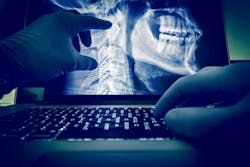With the U.S. healthcare system undergoing rapid and transformational change on all levels and across countless dimensions, it would be unrealistic to expect that any medical specialties would somehow remain “exempt” from said change. Indeed, even the most cursory scan of the full spectrum of medical specialties, from primary care specialties like family medicine and internal medicine, to the most procedurally focused ones like orthopedics and oncology, reveals not a single exception to the broad generalization of massive change across specialties.
That said, the various medical specialties are also all changing in their own ways, as federal and state policy and payment changes, broad industry and business trends, clinical practice shifts, and medical-technology and information-technology changes of different types affect them individually and with different emphases and particularity.
Radiology, always one of the most technologically oriented specialties, is caught in a particularly complex and interesting swirl of diverse trends of all sorts—policy/payment, business, clinical-practice, and medical-tech and information-tech trends. And radiologists are caught up in that swirl. On the one hand, they are facing tremendous reimbursement pressure, as the federal, state and private purchasers and payers of healthcare are balking at the high costs of diagnostic imaging procedures and equipment, and are putting the brakes on unrestrained, fee-for-service-based reimbursement for diagnostic imaging procedures.
At the same time, the economics of radiological practice are changing quickly. While the demand for diagnostic imaging services and diagnostic imaging reports continues, that demand remains uneven across different healthcare regions, local markets, and even micro-areas. That fact, and the expense of maintaining radiological practices, have combined with rapidly improving imaging informatics technology and communications technology, to spur the rapid advance of remote radiological practice, literally spanning the globe—with a huge cohort of remote radiologists in India, among clinicians who were trained in the United States and retain state-based medical licenses, while remote-reading from India—but also across the U.S.
And that in turn has led to the rapid consolidation of radiological practices, under a variety of auspices, many of them taking on remote-reading volume from across the U.S., as well as locally to themselves.
Then of course, there are the changes sweeping imaging informatics itself—with advances in technology and with the consolidation of the healthcare provider space leading to new realities for radiologists. PACS (picture archiving and communications systems) systems are becoming more closely interfaced with electronic health record (EHR) systems, which in turn are erasing the need for standalone RIS (radiology information system) solutions. What’s more, the shift towards vendor-neutral archive (VNA) strategies that unify the storage and sharing of images from across “-ologies” (radiology, cardiology, dermatology, gastroenterology, pathology, and beyond), is pushing PACS into the middle of the enterprise-wide mix. In other words, PACS is no longer an island unto itself. And that, too, is a factor changing radiological practice.
Can I.T. Help Radiologists Become “True Consultants”?
So where does all this leave practicing radiologists? Some, frankly, are finding themselves at least a little bit bewildered, as the volume-based system they’ve been trained to practice in and have been practicing in, shifts noticeably. Others are finding themselves comfortable with change, and moving to adapt to it. Among those is Christopher Deible, M.D., who has been practicing as a clinical radiologist for 12 years, all of those years at the vast, 20-plus-hospital UPMC health system in Pittsburgh. “I actually started in radiology at a unique time,” Deible says. “When we started residency, we were actively converting our imaging from film-based to PACS-based. I still ran up to some of the ICUs to read films. Today, we might go to a unit, or something, but we would look at things on a PACS system. So we’ve definitely accomplished the goal of making images digital, enterprise-wide. The role of the radiologist has definitely diminished to some extent, with a focus on volume—even to the point where clinicians used to come look at images with radiologists, and that kind of disappeared. So the ability to consult now virtually, that’s where we need to go,” he says. “And we still have a lot of challenges in distributing images from one hospital or medical group to another. With regard to reports, there still remains an element of delay in distributing reports with images. And with regard to radiologists becoming consultants, we’re still working on that.”
So how can radiologists become true consultants to referring physicians? And how does IT figure into that frame? “I think it comes in, in two areas,” Deible says. “One is the pre-imaging consult. To some extent, we leave that now to some standard appropriateness software, but a direct personal, telephone or in-person consult might be helpful. A second example—perhaps the ordering physician may need a clarification or an amplification, or even, they’re not sure what to do with a finding—so, pre-exam and post-exam,” he says, there is the opportunity for a more granular type of consultation.
The entire landscape is in fact already changing, says Rasu Shrestha, M.D., chief innovation officer at UPMC, and also a practicing radiologist. “My perspective is that the role of the radiologist is already evolving from a diagnostician simply churning out report after report after report, to that of a physician consultant,” Shrestha says. “And that’s the transition we need in the industry, as we move from volume-based to value-based care delivery. And how do we help radiologists make that leap from being a pure diagnostician to a physician consultant?” he asks.
Rasu Shrestha, M.D.
“Meanwhile,” Shrestha continues, “healthcare is moving towards more of a collaborative care model. We still have hospital-centric, episodic-focused, siloed care, and those elements essentially define the current reality of fee-for-service. As we evolve towards more of a collaborative care model, the focus moves towards collaborative pathways, patient-centric care; and we’re looking at outcomes more than we ever were. And from an IT perspective, we’re looking at interoperability as a driver of care, and looking at standards and standardized interfaces as a de facto enabler of new care models. So we’re moving more into an outcomes-driven reality, and the radiologist plays a really critical role.”
That really is where healthcare IT plays such an important facilitating role in the shifts that are beginning to take place in radiology practice. As Deible puts it, “Availability, reliability, and access are very important elements. When we practiced in more of a departmental, siloed context, as a radiology department, reliability, availability, and access were already important, but not as important as now. Now, they help define what we exist for.” In fact, he says, “In the volume-based environment in which we functioned, two big measures were report turnaround time and volume of studies per hour and day. Now, within a collaborative-care model, it’s not just those two metrics, but a whole range of metrics, including clinical quality metrics, utilization management, and service quality metrics.”
Very importantly, Deible notes, “The things we’re measuring rely heavily on the system being up, and also, access. It’s not just about me as a radiologist having access to the images and studies, but about many things: how do we have access to additional data around a patient that might exist in an EMR or beyond? And then, as we’re looking at things from a care team perspective, access, availability, and reliability become extremely important, because now we’re looking at this in a different context—the radiologist working with the cardiologist or the oncologist in specific contexts, for example, putting a plan around a cancer patient. So the workspace changes. And that happens either directly through the EMR, or the tablet, or the zero-footprint viewers they might have on their desktops.”
New Information Technologies Invade the Practice Space
On top of everything else, some leading-edge technologies, including machine learning and pattern recognition, are beginning to make their way into radiology practice now. Pattern recognition has actually been used in imaging for some time, but, as Bradley Erickson, M.D., Ph.D., professor of radiology and associate chair of research in radiology at the Mayo Clinic in Rochester, Minn., told Healthcare Informatics senior contributing editor David Raths, for the March Top Ten Tech Trends article on value and interoperability in imaging informatics, it has never been extremely successful.
Bradley Erickson, M.D., Ph.D.
But more recently “deep learning” has shown great promise. “My lab and a few others are starting to get pretty good success at applying deep learning to medical images for making traditional diagnoses of a tumor,” he said in that story. “With traditional machine learning, when we would calculate things like intensity and edges, we had 80 to 85 percent accuracy, but with deep learning, we are now getting better than 90 percent accuracy,” Erickson said. Researchers also are starting to be able to figure out genomic properties of tumors with images, he added. “Traditionally, one can understand how an x-ray machine or MRI scanner works,” he told Raths. “With deep learning, it is much harder to understand how or what property of an image you are looking at in order to make a determination.”
For that article, Raths also spoke with Christopher Roth, M.D., Duke University Medical Center’s vice chair of information technology and clinical informatics and director of its imaging informatics strategy, who spoke about the drive towards enterprise strategies. While the shift towards enterprise strategies in imaging informatics has taken some time to pick up speed, Roth believes that that is starting to change now. One reason? The potential inherent in averting redundant testing, and in helping providers get access to the information they need—and not having CDs sitting in closets. “The second driver is information privacy and security, and that gets back to those same CDs sitting in closets or on thumb drives or on mobile devices,” Roth emphasized. “We want to meet our providers at the point of care and fit into their work flows, while still meeting the organization’s macro-level concern about security,” Roth told Raths.
Christopher Roth, M.D.
Tremendous Opportunity for Healthcare I.T. Leaders Going Forward
So, where do CIOs, CMIOs, and other healthcare IT leaders fit into this landscape? They figure into it in a very major way, say industry experts and observers, and those in the trenches. Virtually all CIOs and CMIOs have at least some awareness now of the need to move towards enterprise-wide solutions, including VNAs, even if they might not yet have begun work yet on implementing such strategies in their own organizations.
What’s more, the entire phenomenon of health information exchange (HIE) is beginning to undergo its own transformation with regard to diagnostic images, as HIEs begin to ingest and share those images across communities, regions, states, and even inter-state regions. Initiatives in states like Colorado, Utah, Nebraska, Michigan, and Maine, among others, are breaking past barriers in this regard.
In addition, beyond the development and expansion of the IT infrastructure to improve radiological practice and the medical practice of all physicians is tremendously important, of course—healthcare IT leaders, going forward, can support radiologists in transforming radiological practice, along several important dimensions, as IT will truly be an enabler to radiological practice transformation.
UPMC’s Deible puts it this way: in the next few years, he says, he will be active in “[t]rying to get radiologists more pertinent clinical information as they interpret, so that we end up answering the questions better, and provide better reports—that will be important. And that means that we need greater interoperability. There was a lot of buzz at RSNA [the annual conference of the Radiological Society of North America, held at the end of November and beginning of December last year in Chicago] and elsewhere last year, about providing appropriate and pertinent clinical information at the point of diagnosis. And also having the ability to communicate with other clinicians. Radiologists have gotten away from that collaboration, and moving forward to reintegrate that element into our practice.”
“I would agree with Dr. Deible,” Shrestha says. “If you go back to the basics, it’s really important for us to measure what we want to improve. At the same time, you have to incentivize the measures that matter the most. And if you look at this change in paradigm, we’ve essentially been incentivizing the making of widgets. Now that we’re incentivizing what we want to improve, we need the right systems to incentivize what matters the most. And that includes baseline measures around outcomes, and around cost. How do we make sure we have low cost compared to competitors, and that we’re doing things as efficiently as possible? So we’re looking at scale, across -ologies, etc. And the differentiators that will separate the wheat from the chaff, so to speak: one is around quality. Stronger adherence to evidence-based clinical practices; and the second is service experience. How do we make sure we have high satisfaction around patients and physicians? And how do we translate that experience into value? Including improved outcomes.”
And that means leveraging IT to support new ways to perform clinical peer review. This has long been a contentious area for radiology, as it has been felt by many practicing radiologists to have carried a whiff of punition around it. In fact, says Deible, “We’re dealing with some of this in our department these days. We’ve instituted a number of new ways of reviewing quality. We had a traditional peer review process, based on, we give you a certain number of cases, and you rate them with a score, and everyone compares. But now, the focus is on incentivizing participation in the peer review process. If you submit a certain number of cases, your score improves. So that moves it away from the punitive. And we have a tremendous amount of new information that radiologists are sharing with each other that either didn’t exist before, or just didn’t get back to radiologists from others. So moving the incentive towards participation rather than the focal score, will help. And we can incentivize by bringing new information; because in general, everybody appreciates learning new information that can help them, especially when it doesn’t feel punitive.”
“Today, peer review is more of this thing you do on the side, so that reinforces a sense of the punitive nature of it,” Shrestha says. “With the advances in technological capabilities, peer review should literally sort of fade away into what we’re doing on a day-to-day basis. Clinical and service quality should simply be measured on a day-to-day basis; and if that’s what’s measured, rather than how many studies you performed and then we’ll do a peer review on the side to make sure you’re up to scratch—if that can be changed, it will be better for radiologists. Radiologists always wanted to focus on quality, but the traditional systems like RIS and PACS reinforced a punitive approach. So technology that supports quality is where we need to move.”
In the end, everyone agrees, leadership and facilitation on the part of healthcare IT leaders, especially CIOs and CMIOs, and leaders of imaging informatics, will be a very important element in transforming radiological practice, as the entire U.S. healthcare system undergoes transformation. And the facilitation of practice transformation that they can participate in will in turn reduce some of the stressors that radiologists face as all the policy, payment, business, and medical-technological changes continue to impact them at the same time. Within the next decade, as the entire landscape of radiology practice undergoes profound transformation, the facilitation into healthcare IT change that healthcare IT leaders can help lead, really will make an enormous difference—to radiologists themselves, to their colleagues the referring physicians, to all the other clinicians and the staff people they work with, to the hospitals, medical groups, and health systems in which they are embedded—and ultimately, to their patients and communities. Meanwhile, this train of transformational change has already pulled out of the station, everyone agrees—and it’s time to get on quickly.





